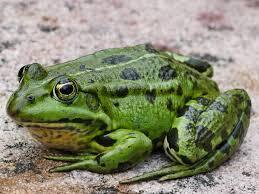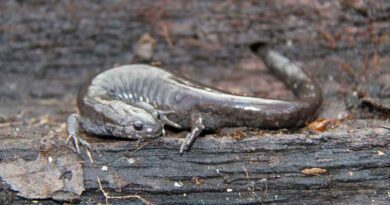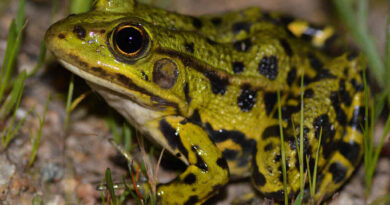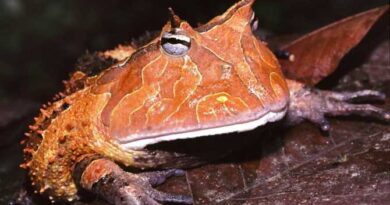Edible frog
Edible Frog: A Hybrid Amphibian Thriving in Europe’s Wetlands with Unique Traits and Conservation Challenges”
Introduction
The Edible Frog is an intriguing species often found in diverse habitats. This frog is notable for its lack of a dark eyepatch, a feature commonly seen in other frogs like the Brown Frog group, including the Agile Frog, Common Frog, and Moor Frog. Unlike these species, the Edible Frog rarely exhibits a dark area on its temporal foreleg, which could lead to misidentification. In the field, one of the most effective ways to identify this frog is by its mating call, which is notably noisy and can be described as growling or rattling. This call has a rapid sequence of tones, typically ranging from twenty to thirty, each lasting approximately 1.5 seconds. Compared to the Marsh Frog, which emits harsh sounds, or the Pool Frog, which is even faster, the Edible Frog presents a unique auditory signature.
In terms of appearance, the Edible Frog has a dorsal coloration that varies from green-brown to green on its head and sides. Its underside is usually whitish or light grey, though it may sometimes appear marbled. The male Edible Frog has greyish vocal sacs, differing from the white sacs of the Marsh Frog and the blackish sacs of the Pool Frog. Another distinctive feature is the metatarsal tubercle around the heel, which helps in identification. However, capturing these animals is often restricted by conservation laws to prevent disturbance.
Distribution
The Edible Frog thrives in a variety of habitats, but one notable location is the Donau-Auen National Park, where its range covers the entire park. This amphibian is commonly found in wetlands and other water-rich environments. While Edible Frogs are frequently sighted in these areas, they have been noted to exhibit a fascinating behaviour pattern. These frogs often hibernate between September and October, demonstrating their adaptability and seasonal variation in habitat use.
In contrast to their widespread presence, Edible Frogs are rarely seen in more agricultural areas. This suggests that their preferred habitats are closely tied to water environments, making wetlands and similar settings crucial for their survival. As someone who has observed these frogs in the wild, I’ve noted how their hibernation spots are meticulously chosen, highlighting their intricate relationship with their surroundings. The Donau-Auen National Park provides a prime example of how the Edible Frog has adapted to its environment, thriving in diverse conditions yet remaining sensitive to habitat changes.
Endangerment and Conservation Status
The Edible Frog has faced changing status over time. Once considered a distinct species, it was later identified as a hybrid of two parental species, the Marsh Frog and the Pool Frog. Historically, these frogs were often sighted in the Danube wetlands, but today, they are rarely seen in the surrounding agricultural areas. This decline is partly due to habitat changes and environmental protection acts which have been crucial in safeguarding amphibians like the Edible Frog.
Despite legal protections, the Edible Frog’s habitat continues to face threats. Amphibians are generally protected under these acts, yet Green frogs in particular are still at risk due to their complex reproductive behaviour and the challenge of conservation efforts in diverse and changing environments. The presence of these frogs in conservation areas remains vital as they help monitor the health of aquatic ecosystems.
Behaviour
During summer, Edible Frogs are amphibians that you can almost always find in the immediate vicinity of water. They eat nearly everything, from insects and worms to spiders. Younger animals also enjoy mosquitoes. As temperatures drop, Edible Frogs hibernate from September to October, mostly on land, though they less frequently do so under water. They often go considerable distances in their search for suitable hibernation spots. A variety of landscapes near water is essential, offering piles of leaves, deadwood, crevices in the earth, and fallen trees. These structures are crucial for their winter survival, ensuring they have safe places to rest and stay protected.
Unique Features of the Edible Frog
The Edible Frog is a fascinating creature with some special characteristics. This frog was once considered a distinct species, but recent evidence suggests it’s actually a hybrid form of two parental species: the Marsh Frog (Pelophylax ridibundus) and the Pool Frog (Pelophylax lessonae). The genetic material of the Edible Frog indicates it’s likely produced through a complex procedure involving crossing these species. Despite this, it may not completely mix their genes.
In terms of physical characteristics, females of this species range between 5 and 9 cm (2.0 to 3.5 in) in length, while males are slightly larger, between 6 and 11 cm (2.4 to 4.3 in). The widespread nature of this frog is highlighted by its common names like the dark-spotted or black-spotted pond frog. Its habitat includes a range of European environments where it remains common and adaptable, thriving in various water bodies and ponds.
The frog’s reproductive behaviour is intriguing. It undergoes complex initial phases and fertilization, which are not yet fully explained. Additionally, triploid organisms have been observed, which develop with an extra set of chromosomes from the parental species. These organisms might co-exist in various combinations within their body of water, contributing to a diverse common population. There’s often separation among individual types, each showing differences in their reproductive behaviour. Sometimes, a crossing with other Green Frogs from surrounding areas might even be possible, adding another layer of complexity to their situation.
When you think of the edible frog (Pelophylax esculentus), it’s intriguing to note its endemic nature. This species is found across northern Europe, stretching from France and western Russia to Estonia, Denmark, Bulgaria, and northern Italy. Although it’s primarily native to these areas, the edible frog has also been introduced to regions like Spain, Norway, and the United Kingdom. This natural range shows how adaptable this species is, often thriving in various environments.
This hybridization is a complex process where the genetic material from each parent is handled in a unique way. The frog reproduces hemiclonally, meaning half of the genome is passed on clonally, and the other half is mixed during reproduction. This results in a diverse range of hybrid populations that can reproduce with either parent species through mating and backcrosses. It’s a dynamic example of how genetic diversity can manifest in natural populations.
With its green coloration and adaptability, the edible frog demonstrates how a hybrid species can seamlessly integrate into diverse environments, making it a fascinating subject of study for herpetologists and amphibian enthusiasts alike.



